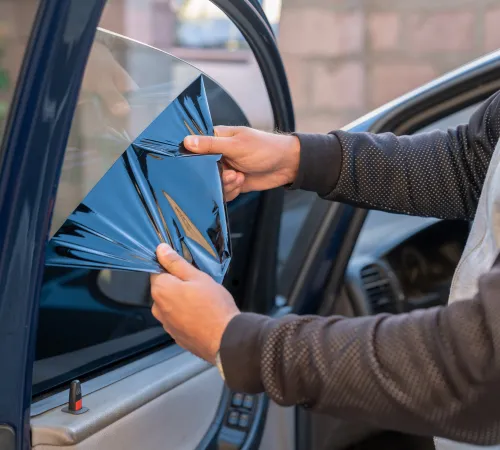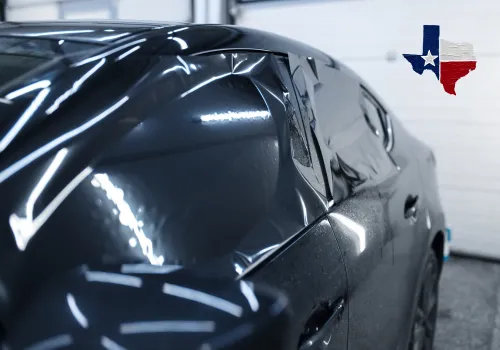Knowing Texas Laws for Vehicle
Window Tint
Knowing Texas Laws for Vehicle Window Tint
Window Tint Laws
Knowing the Laws Could Save Your Window Tint

Are you aware of the complexities tied to Texas window tint laws? Each layer of tint on your vehicle's glass carries legal weight. It’s pivotal for drivers to align with legal window tint Texas standards to avoid penalties. With vehicle tint regulations Texas dictating specific visibility levels for each window, compliance is key.
It’s a routine Texas window tint inspection or a spot check by authorities, knowing your state tint laws and Texas auto tint rules could save you from fines. Your car window tint Texas meets the window tint legal limit Texas to stay on the right side of the law. Adhering to Texas vehicle tint guidelines is not just about legality; it's a commitment to roadway safety for everyone

Visible Light Transmission (VLT) Percentages
In Texas, the requirements for Visible Light Transmission (VLT) are set to confirm that drivers have adequate visibility while still allowing for privacy and protection from sunlight. For passenger vehicles, the front side windows must allow more than 25% of light to pass through, clear visibility. The rear side windows and rear window can be tinted to any darkness if the vehicle is equipped with dual side mirrors, providing more flexibility for privacy and sun protection.
Multi-purpose vehicles, such as SUVs and vans, are subject to the same VLT requirements for the front windows, but also allow any darkness on the rear and back windows, promoting utility and versatility across different vehicle types. These regulations are designed to balance safety on the roads with personal preferences for window tinting
Windshield Tinting Regulations in Texas

Texas has specific rules for windshield tinting to ensure safety while providing sun protection. Tinting is allowed only above the AS-1 line or within the top five inches of the windshield. This area can have a tint that permits at least 25% light transmission, helping reduce sun glare while maintaining clear visibility through the windshield.
These regulations are in place to ensure drivers have an unobstructed view of the road, which is crucial for safe driving. Vehicle owners must comply with these guidelines to avoid fines and pass safety inspections.
Texas has specific rules for windshield tinting to ensure safety while providing sun protection. Tinting is allowed only above the AS-1 line or within the top five inches of the windshield. This area can have a tint that permits at least 25% light transmission, helping reduce sun glare while maintaining clear visibility through the windshield.
These regulations are in place to ensure drivers have an unobstructed view of the road, which is crucial for safe driving. Vehicle owners must comply with these guidelines to avoid fines and pass safety inspections.

Adhering to Texas' windshield tinting regulations is not just about avoiding penalties; it's also about ensuring optimal driving safety. The rules are designed to strike a balance between effective sun glare reduction and maintaining a clear line of sight for the driver. This balance is particularly important in Texas, where intense sunlight can make driving difficult without adequate protection.
Additionally, following these guidelines helps maintain the vehicle's resale value. Prospective buyers often look for vehicles that comply with state laws to avoid the hassle of modifications. Ensuring your vehicle meets these tinting standards can make it more attractive to potential buyers and easier to sell in the future.
Tint Reflection and Mirroring Laws
Texas enforces specific regulations regarding the reflectivity of window tints to confirm that vehicle windows do not create excessive glare for drivers. The state mandates that both front and back side windows on any vehicle, whether a sedan, SUV, or van, must have a reflectivity of no more than 25%. This limitation is important to reduce glare and heat inside the vehicle, increasing comfort without compromising safety by obscuring the driver's view or distracting other road users.
These standards are part of Texas's broader efforts to balance the benefits of window tinting such as increased privacy and reduced heat load with the need for safe driving conditions under varying light and weather circumstances. Adhering to these reflectivity limits is essential for passing vehicle inspections and avoiding fines
Color Restrictions for Window Tint
Selecting the ideal window tint percentage can greatly affect your nighttime driving visibility. While darker tints offer superior UV protection and privacy, they may reduce your ability to see clearly after dark. Finding a balance between day and night usability is crucial, particularly if you often drive in low-light conditions.
For frequent nighttime drivers, lighter tint shades are usually recommended to maintain clear visibility while still providing some level of privacy and UV protection. It’s important to carefully evaluate car window tint options to meet your needs without compromising safety.
Selecting the ideal window tint percentage can greatly affect your nighttime driving visibility. While darker tints offer superior UV protection and privacy, they may reduce your ability to see clearly after dark. Finding a balance between day and night usability is crucial, particularly if you often drive in low-light conditions.
For frequent nighttime drivers, lighter tint shades are usually recommended to maintain clear visibility while still providing some level of privacy and UV protection. It’s important to carefully evaluate car window tint options to meet your needs without compromising safety.


Utilizing a tint percentage guide can help you understand how various darkness levels affect your visibility, especially in dim lighting. This ensures that your choice of tint allows you to drive safely at all hours while still achieving the desired benefits. Lastly, always ensure your chosen tint adheres to legal window tint limits. This not only helps you avoid fines but also guarantees maximum visibility and safety for both daytime and nighttime driving.
Window Tint Medical Exemptions in Texas
Texas recognizes that some individuals may require darker tints than what is generally allowed under state tint laws due to medical conditions. To accommodate this need, Texas window tint laws include provisions for medical exemptions, allowing for more heavily tinted windows as needed. Individuals must provide documentation from a licensed physician stating the medical necessity for darker tints. This documentation must be presented upon request by law enforcement or during any Texas window tint inspection to verify the legitimacy of the darker tint in relation to the medical condition cited.
The process to apply for a medical exemption is straightforward but requires strict adherence to documentation and procedural rules. Applicants must confirm that their physician's statement is detailed and includes a clear diagnosis that justifies the need for darker window tints. The Texas Department of Public Safety reviews these applications to confirm they meet all medical and legal standards before granting an exemption. Once approved, the exemption allows individuals to modify their vehicle tints beyond the standard window tint legal limit in Texas, thus providing them with the necessary protection against sunlight that could exacerbate their medical conditions.
Certification Requirements for Tint Manufacturers
Texas tint laws mandate that all tint manufacturers who wish to sell their products in the state must first certify that their window films meet specific safety and performance standards. This certification is important as it reassures consumers that the products they are purchasing are not only effective but also compliant with Texas vehicle tint guidelines. The certification process involves rigorous testing of the tint films to confirm they adhere to standards regarding light transmission, reflectivity, and color restrictions.
Once a manufacturer's tint film is certified, it must be labeled appropriately to indicate its compliance with Texas auto tint rules. This labeling helps consumers and law enforcement officials easily identify whether the tint installed on a vehicle is legally compliant. The requirement for certification and labeling is designed to protect consumers from inferior products that could impair visibility and safety, potentially leading to accidents or enforcement actions against the vehicle owner.
Ensuring Compliance and Safety on Texas Roads
Understanding and adhering to Texas' vehicle window tint laws is essential for both safety and legal compliance. By following the state's guidelines, drivers not only protect themselves from potential fines but also ensure optimal visibility on the road, which is crucial for safe driving in varying light conditions.
Moreover, compliance with these regulations contributes to smoother vehicle inspections and maintains the value of your vehicle in the long run. By choosing the right tint and ensuring it meets legal standards, you support safer driving environments and enjoy peace of mind on every journey across Texas.
Get our latest news and promos


SATISFACTION GUARANTEED

UNPARALLELED SUPPORT
Sun Shield of Lubbock
Social Media
Payments Accepted







